Analysis of Individual Differences Influencing Teaching Strategies
VerifiedAdded on 2022/09/13
|6
|957
|13
Homework Assignment
AI Summary
This assignment explores the crucial role of instructional strategies in education, emphasizing how they are influenced by individual differences. It delves into various factors, including health literacy levels, which necessitate modified teaching approaches. The document highlights that individuals with varying health literacy may require tailored educational materials and methods. Furthermore, it addresses the impact of different abilities, such as physical disabilities, and the need for adaptive strategies like the use of assistive technologies. Cultural backgrounds are also examined, with a focus on language barriers and the importance of cross-cultural understanding in the classroom. The paper also considers other influential factors like demographic variables, reading skills, and learning capabilities, advocating for assessments to determine the most effective instructional techniques for diverse learners. The conclusion underscores the necessity of adapting instructional strategies to cater to a wide array of individual differences, ensuring effective learning outcomes for all students.
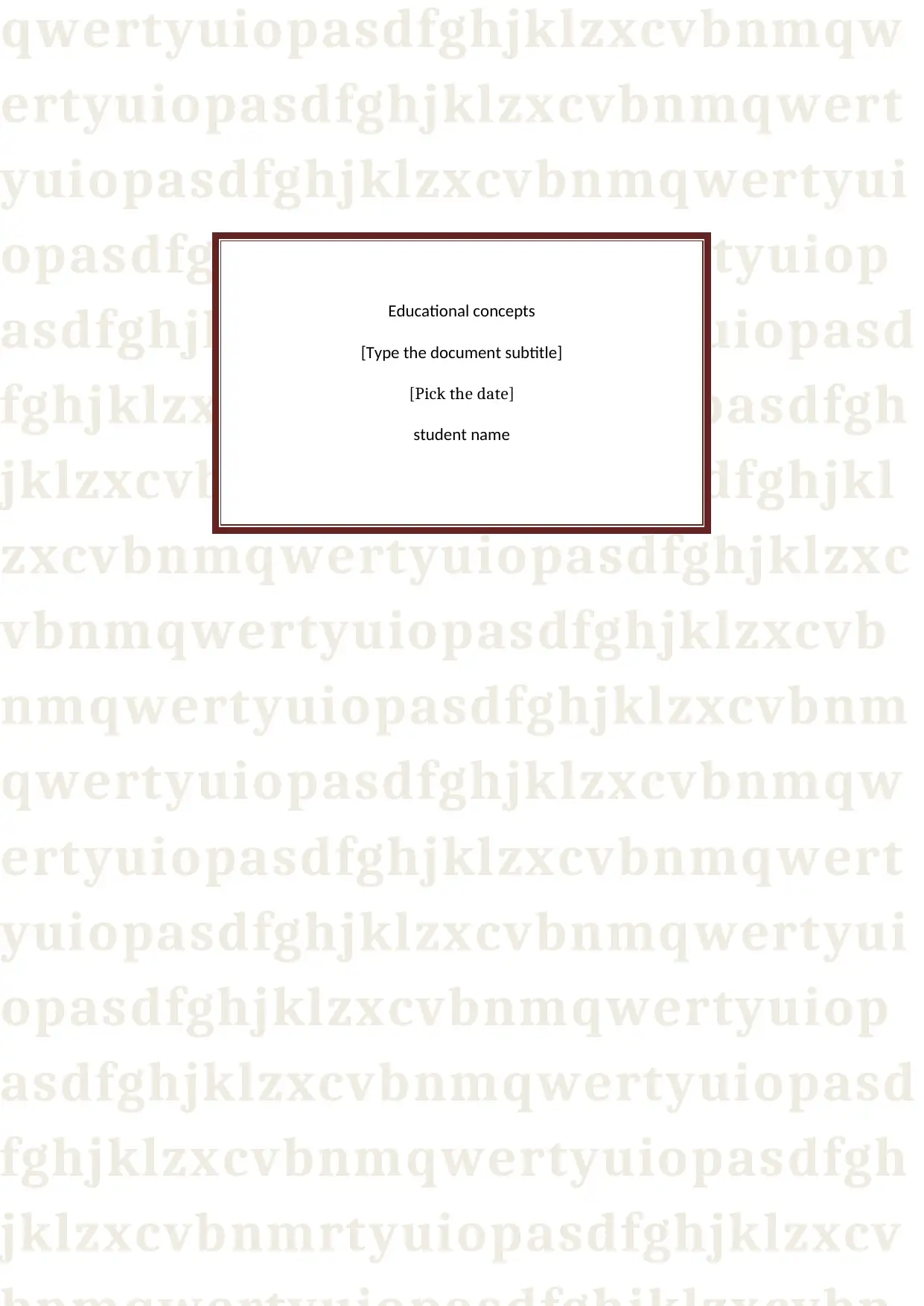
qwertyuiopasdfghjklzxcvbnmqw
ertyuiopasdfghjklzxcvbnmqwert
yuiopasdfghjklzxcvbnmqwertyui
opasdfghjklzxcvbnmqwertyuiop
asdfghjklzxcvbnmqwertyuiopasd
fghjklzxcvbnmqwertyuiopasdfgh
jklzxcvbnmqwertyuiopasdfghjkl
zxcvbnmqwertyuiopasdfghjklzxc
vbnmqwertyuiopasdfghjklzxcvb
nmqwertyuiopasdfghjklzxcvbnm
qwertyuiopasdfghjklzxcvbnmqw
ertyuiopasdfghjklzxcvbnmqwert
yuiopasdfghjklzxcvbnmqwertyui
opasdfghjklzxcvbnmqwertyuiop
asdfghjklzxcvbnmqwertyuiopasd
fghjklzxcvbnmqwertyuiopasdfgh
jklzxcvbnmrtyuiopasdfghjklzxcv
Educational concepts
[Type the document subtitle]
[Pick the date]
student name
ertyuiopasdfghjklzxcvbnmqwert
yuiopasdfghjklzxcvbnmqwertyui
opasdfghjklzxcvbnmqwertyuiop
asdfghjklzxcvbnmqwertyuiopasd
fghjklzxcvbnmqwertyuiopasdfgh
jklzxcvbnmqwertyuiopasdfghjkl
zxcvbnmqwertyuiopasdfghjklzxc
vbnmqwertyuiopasdfghjklzxcvb
nmqwertyuiopasdfghjklzxcvbnm
qwertyuiopasdfghjklzxcvbnmqw
ertyuiopasdfghjklzxcvbnmqwert
yuiopasdfghjklzxcvbnmqwertyui
opasdfghjklzxcvbnmqwertyuiop
asdfghjklzxcvbnmqwertyuiopasd
fghjklzxcvbnmqwertyuiopasdfgh
jklzxcvbnmrtyuiopasdfghjklzxcv
Educational concepts
[Type the document subtitle]
[Pick the date]
student name
Paraphrase This Document
Need a fresh take? Get an instant paraphrase of this document with our AI Paraphraser
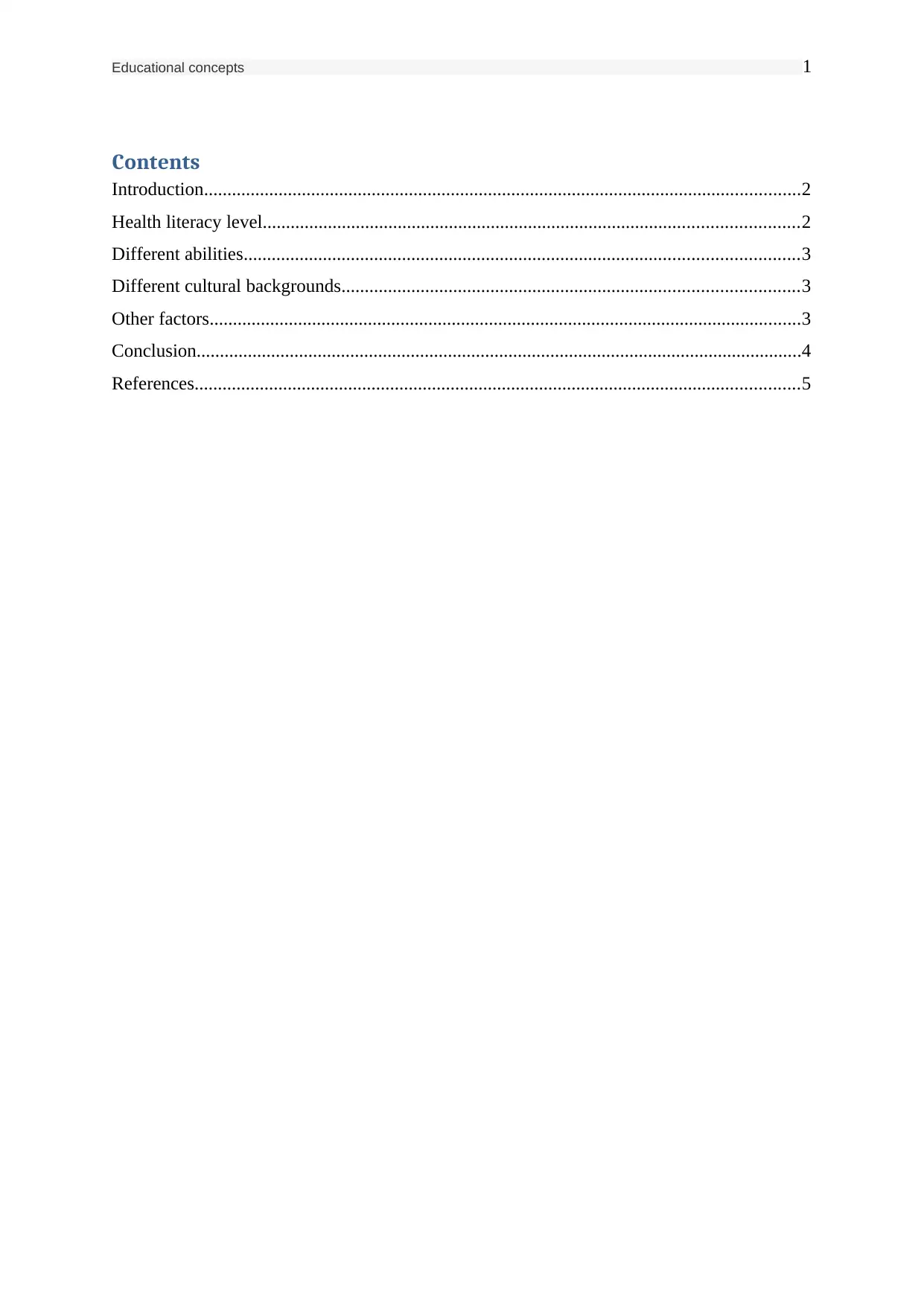
Educational concepts 1
Contents
Introduction................................................................................................................................2
Health literacy level...................................................................................................................2
Different abilities.......................................................................................................................3
Different cultural backgrounds..................................................................................................3
Other factors...............................................................................................................................3
Conclusion..................................................................................................................................4
References..................................................................................................................................5
Contents
Introduction................................................................................................................................2
Health literacy level...................................................................................................................2
Different abilities.......................................................................................................................3
Different cultural backgrounds..................................................................................................3
Other factors...............................................................................................................................3
Conclusion..................................................................................................................................4
References..................................................................................................................................5
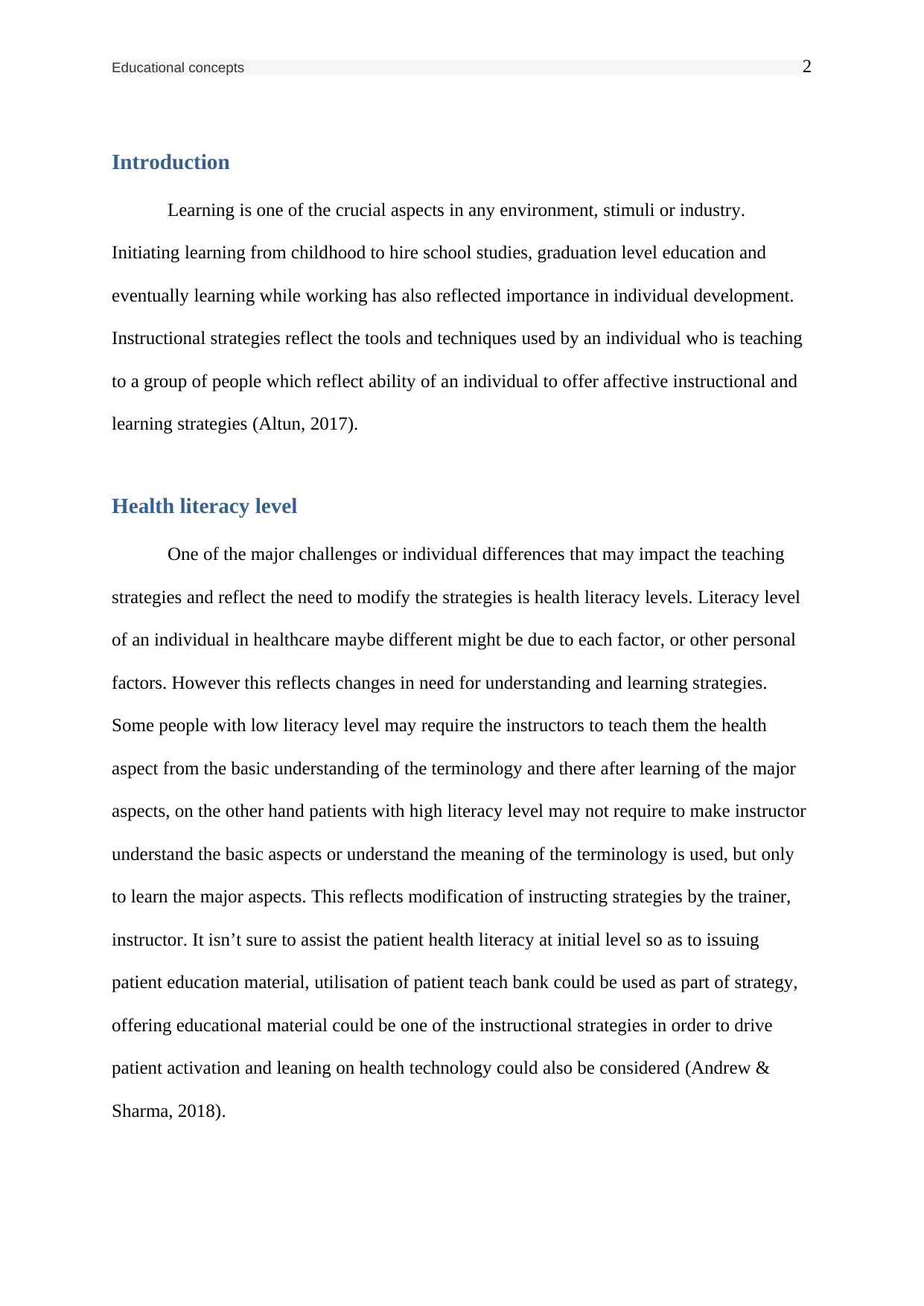
Educational concepts 2
Introduction
Learning is one of the crucial aspects in any environment, stimuli or industry.
Initiating learning from childhood to hire school studies, graduation level education and
eventually learning while working has also reflected importance in individual development.
Instructional strategies reflect the tools and techniques used by an individual who is teaching
to a group of people which reflect ability of an individual to offer affective instructional and
learning strategies (Altun, 2017).
Health literacy level
One of the major challenges or individual differences that may impact the teaching
strategies and reflect the need to modify the strategies is health literacy levels. Literacy level
of an individual in healthcare maybe different might be due to each factor, or other personal
factors. However this reflects changes in need for understanding and learning strategies.
Some people with low literacy level may require the instructors to teach them the health
aspect from the basic understanding of the terminology and there after learning of the major
aspects, on the other hand patients with high literacy level may not require to make instructor
understand the basic aspects or understand the meaning of the terminology is used, but only
to learn the major aspects. This reflects modification of instructing strategies by the trainer,
instructor. It isn’t sure to assist the patient health literacy at initial level so as to issuing
patient education material, utilisation of patient teach bank could be used as part of strategy,
offering educational material could be one of the instructional strategies in order to drive
patient activation and leaning on health technology could also be considered (Andrew &
Sharma, 2018).
Introduction
Learning is one of the crucial aspects in any environment, stimuli or industry.
Initiating learning from childhood to hire school studies, graduation level education and
eventually learning while working has also reflected importance in individual development.
Instructional strategies reflect the tools and techniques used by an individual who is teaching
to a group of people which reflect ability of an individual to offer affective instructional and
learning strategies (Altun, 2017).
Health literacy level
One of the major challenges or individual differences that may impact the teaching
strategies and reflect the need to modify the strategies is health literacy levels. Literacy level
of an individual in healthcare maybe different might be due to each factor, or other personal
factors. However this reflects changes in need for understanding and learning strategies.
Some people with low literacy level may require the instructors to teach them the health
aspect from the basic understanding of the terminology and there after learning of the major
aspects, on the other hand patients with high literacy level may not require to make instructor
understand the basic aspects or understand the meaning of the terminology is used, but only
to learn the major aspects. This reflects modification of instructing strategies by the trainer,
instructor. It isn’t sure to assist the patient health literacy at initial level so as to issuing
patient education material, utilisation of patient teach bank could be used as part of strategy,
offering educational material could be one of the instructional strategies in order to drive
patient activation and leaning on health technology could also be considered (Andrew &
Sharma, 2018).
⊘ This is a preview!⊘
Do you want full access?
Subscribe today to unlock all pages.

Trusted by 1+ million students worldwide
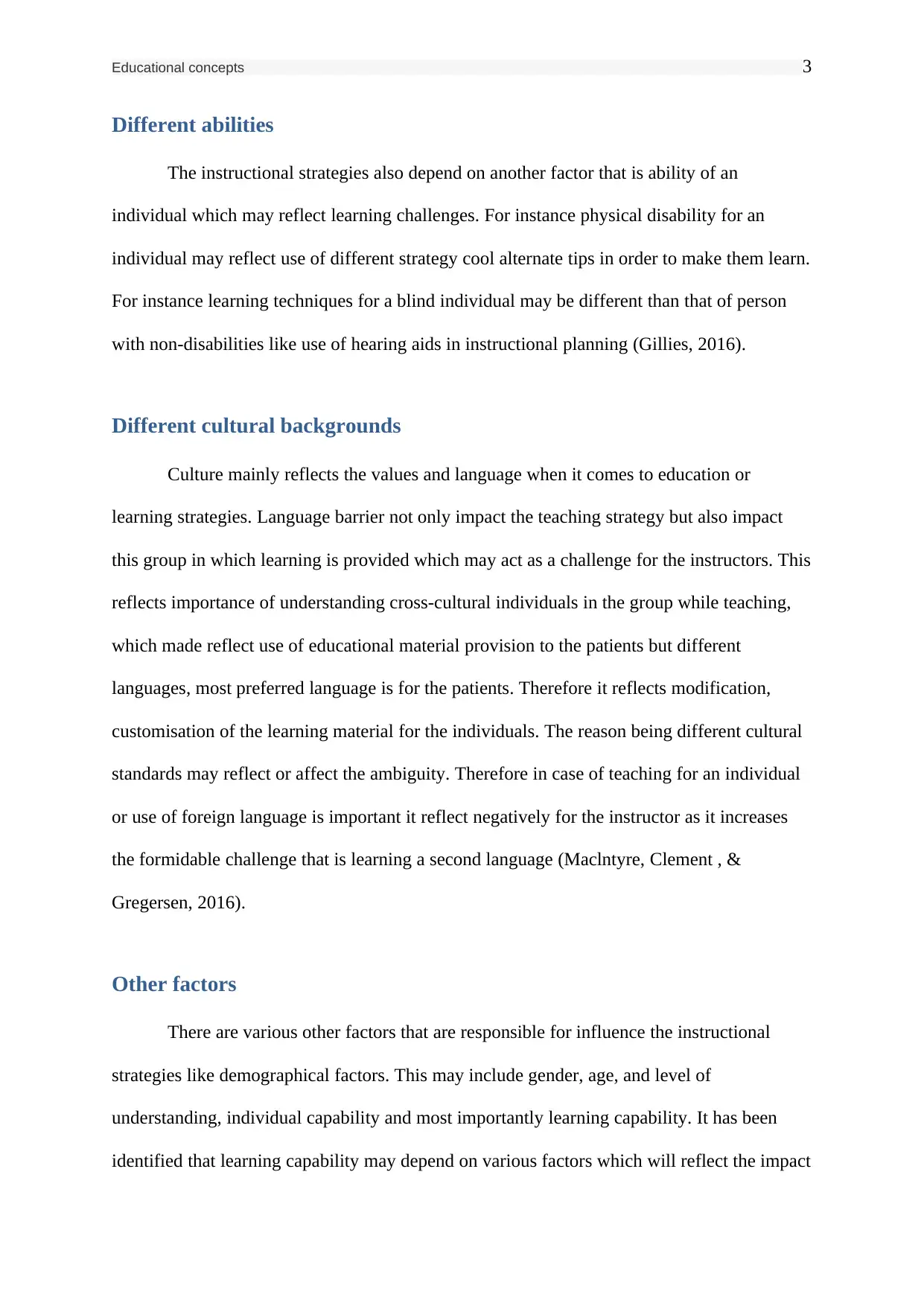
Educational concepts 3
Different abilities
The instructional strategies also depend on another factor that is ability of an
individual which may reflect learning challenges. For instance physical disability for an
individual may reflect use of different strategy cool alternate tips in order to make them learn.
For instance learning techniques for a blind individual may be different than that of person
with non-disabilities like use of hearing aids in instructional planning (Gillies, 2016).
Different cultural backgrounds
Culture mainly reflects the values and language when it comes to education or
learning strategies. Language barrier not only impact the teaching strategy but also impact
this group in which learning is provided which may act as a challenge for the instructors. This
reflects importance of understanding cross-cultural individuals in the group while teaching,
which made reflect use of educational material provision to the patients but different
languages, most preferred language is for the patients. Therefore it reflects modification,
customisation of the learning material for the individuals. The reason being different cultural
standards may reflect or affect the ambiguity. Therefore in case of teaching for an individual
or use of foreign language is important it reflect negatively for the instructor as it increases
the formidable challenge that is learning a second language (Maclntyre, Clement , &
Gregersen, 2016).
Other factors
There are various other factors that are responsible for influence the instructional
strategies like demographical factors. This may include gender, age, and level of
understanding, individual capability and most importantly learning capability. It has been
identified that learning capability may depend on various factors which will reflect the impact
Different abilities
The instructional strategies also depend on another factor that is ability of an
individual which may reflect learning challenges. For instance physical disability for an
individual may reflect use of different strategy cool alternate tips in order to make them learn.
For instance learning techniques for a blind individual may be different than that of person
with non-disabilities like use of hearing aids in instructional planning (Gillies, 2016).
Different cultural backgrounds
Culture mainly reflects the values and language when it comes to education or
learning strategies. Language barrier not only impact the teaching strategy but also impact
this group in which learning is provided which may act as a challenge for the instructors. This
reflects importance of understanding cross-cultural individuals in the group while teaching,
which made reflect use of educational material provision to the patients but different
languages, most preferred language is for the patients. Therefore it reflects modification,
customisation of the learning material for the individuals. The reason being different cultural
standards may reflect or affect the ambiguity. Therefore in case of teaching for an individual
or use of foreign language is important it reflect negatively for the instructor as it increases
the formidable challenge that is learning a second language (Maclntyre, Clement , &
Gregersen, 2016).
Other factors
There are various other factors that are responsible for influence the instructional
strategies like demographical factors. This may include gender, age, and level of
understanding, individual capability and most importantly learning capability. It has been
identified that learning capability may depend on various factors which will reflect the impact
Paraphrase This Document
Need a fresh take? Get an instant paraphrase of this document with our AI Paraphraser
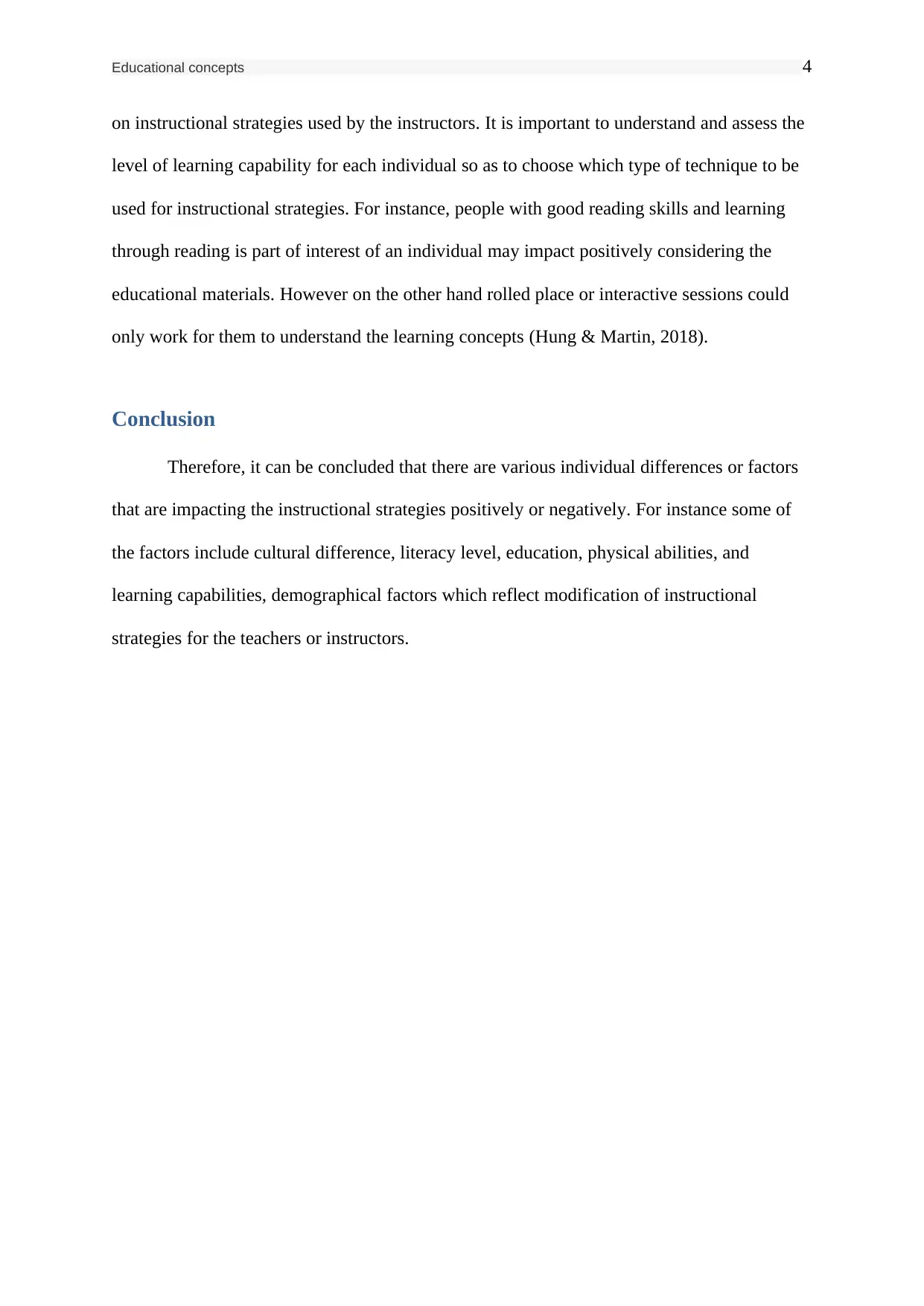
Educational concepts 4
on instructional strategies used by the instructors. It is important to understand and assess the
level of learning capability for each individual so as to choose which type of technique to be
used for instructional strategies. For instance, people with good reading skills and learning
through reading is part of interest of an individual may impact positively considering the
educational materials. However on the other hand rolled place or interactive sessions could
only work for them to understand the learning concepts (Hung & Martin, 2018).
Conclusion
Therefore, it can be concluded that there are various individual differences or factors
that are impacting the instructional strategies positively or negatively. For instance some of
the factors include cultural difference, literacy level, education, physical abilities, and
learning capabilities, demographical factors which reflect modification of instructional
strategies for the teachers or instructors.
on instructional strategies used by the instructors. It is important to understand and assess the
level of learning capability for each individual so as to choose which type of technique to be
used for instructional strategies. For instance, people with good reading skills and learning
through reading is part of interest of an individual may impact positively considering the
educational materials. However on the other hand rolled place or interactive sessions could
only work for them to understand the learning concepts (Hung & Martin, 2018).
Conclusion
Therefore, it can be concluded that there are various individual differences or factors
that are impacting the instructional strategies positively or negatively. For instance some of
the factors include cultural difference, literacy level, education, physical abilities, and
learning capabilities, demographical factors which reflect modification of instructional
strategies for the teachers or instructors.
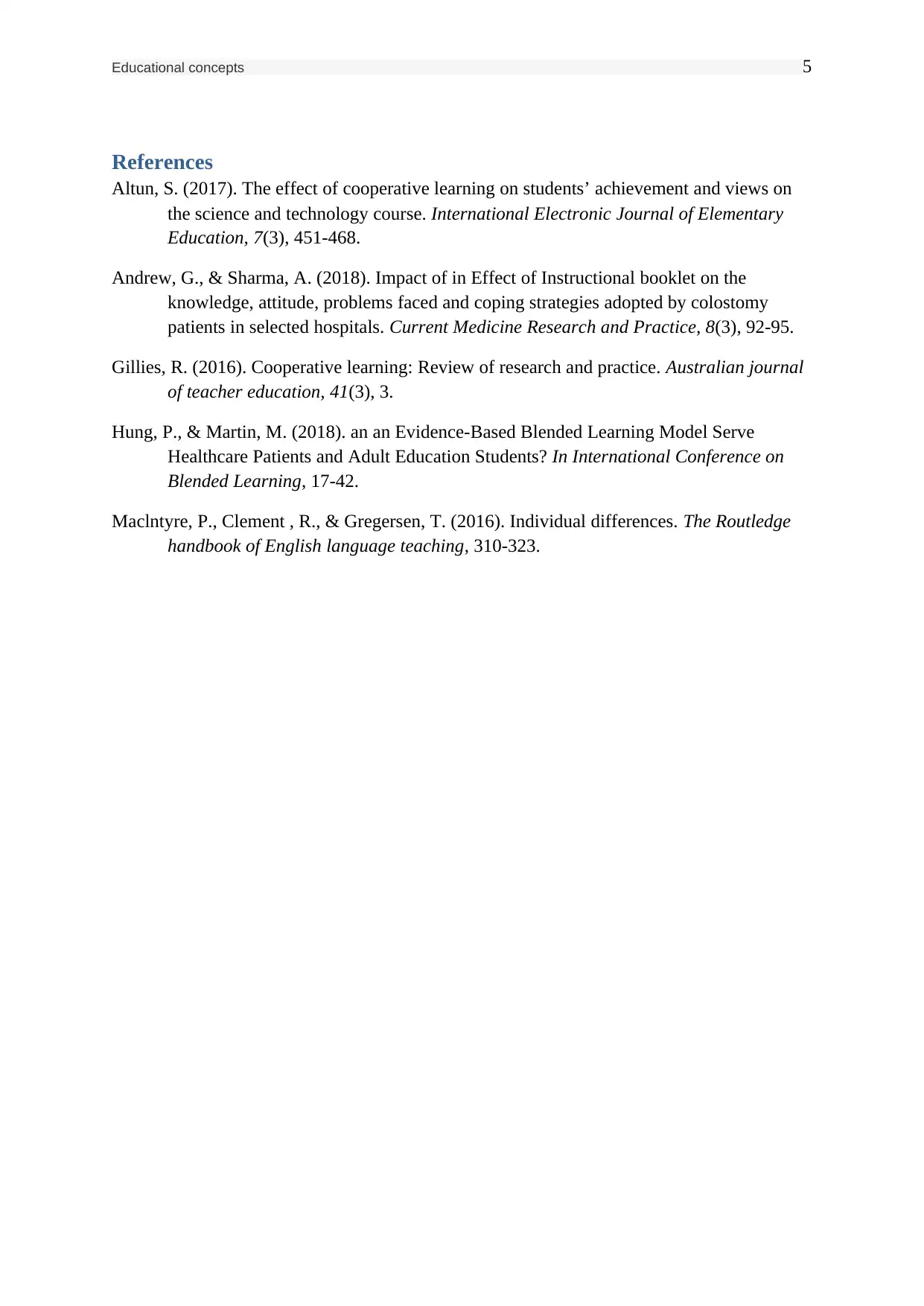
Educational concepts 5
References
Altun, S. (2017). The effect of cooperative learning on students’ achievement and views on
the science and technology course. International Electronic Journal of Elementary
Education, 7(3), 451-468.
Andrew, G., & Sharma, A. (2018). Impact of in Effect of Instructional booklet on the
knowledge, attitude, problems faced and coping strategies adopted by colostomy
patients in selected hospitals. Current Medicine Research and Practice, 8(3), 92-95.
Gillies, R. (2016). Cooperative learning: Review of research and practice. Australian journal
of teacher education, 41(3), 3.
Hung, P., & Martin, M. (2018). an an Evidence-Based Blended Learning Model Serve
Healthcare Patients and Adult Education Students? In International Conference on
Blended Learning, 17-42.
Maclntyre, P., Clement , R., & Gregersen, T. (2016). Individual differences. The Routledge
handbook of English language teaching, 310-323.
References
Altun, S. (2017). The effect of cooperative learning on students’ achievement and views on
the science and technology course. International Electronic Journal of Elementary
Education, 7(3), 451-468.
Andrew, G., & Sharma, A. (2018). Impact of in Effect of Instructional booklet on the
knowledge, attitude, problems faced and coping strategies adopted by colostomy
patients in selected hospitals. Current Medicine Research and Practice, 8(3), 92-95.
Gillies, R. (2016). Cooperative learning: Review of research and practice. Australian journal
of teacher education, 41(3), 3.
Hung, P., & Martin, M. (2018). an an Evidence-Based Blended Learning Model Serve
Healthcare Patients and Adult Education Students? In International Conference on
Blended Learning, 17-42.
Maclntyre, P., Clement , R., & Gregersen, T. (2016). Individual differences. The Routledge
handbook of English language teaching, 310-323.
⊘ This is a preview!⊘
Do you want full access?
Subscribe today to unlock all pages.

Trusted by 1+ million students worldwide
1 out of 6
Related Documents
Your All-in-One AI-Powered Toolkit for Academic Success.
+13062052269
info@desklib.com
Available 24*7 on WhatsApp / Email
![[object Object]](/_next/static/media/star-bottom.7253800d.svg)
Unlock your academic potential
Copyright © 2020–2025 A2Z Services. All Rights Reserved. Developed and managed by ZUCOL.





